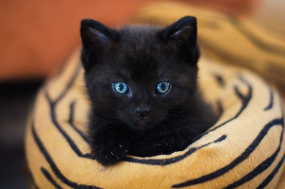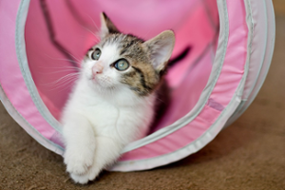KITTENS 11
Fostering kittens may be an amazing experience, but it isn't without its difficulties. Neonatal, or newborn, kittens are extremely vulnerable if they've lost their mother. They are unable to regulate their body heat, cannot see or hear, and can't even go to the bathroom by themselves. Fostering these delicate babies will definitely mean late night feeding sessions, but could also include applying special medicines or going for emergency vet visits. kittens11.blogspot.com/p/your-sitemap.html
📅 جدول المباريات
مباريات الأمس
| الفريق | النتيجة | الفريق | الساعة |
|---|---|---|---|
| ⏳ تحميل... | |||
مباريات اليوم
| الفريق | النتيجة | الفريق | الساعة |
|---|---|---|---|
| ⏳ تحميل... | |||
مباريات الغد
| الفريق | النتيجة | الفريق | الساعة |
|---|---|---|---|
| ⏳ تحميل... | |||
Friday, September 12, 2025
Wednesday, June 26, 2024
Friday, June 21, 2024
Adorable Kitten Snuggles Up in Miniature Bed - Heartwarming Footage
Adorable Kitten Snuggles Up in Miniature Bed - Heartwarming Footage
#shorts #kitten #kittenvideos #kittens #catsvideo Tiny Treasures: Discover the Adorable World of Kittens Snuggling in Miniature Beds If you're in need of a heartwarming pick-me-up, head to YouTube and search for "kitten tiny bed." Prepare to be captivated by a treasure trove of footage showcasing the most adorable feline companions cozying up in miniature sleeping quarters, sure to fill your day with pure joy. These tiny kitties, nestled in their diminutive beds, exude a level of sweetness that will have you melting with every passing second. From fluffy bundles of fur curled up in dollhouse-sized cribs to kittens playfully exploring their miniature abodes, these videos offer a delightful respite from the stresses of daily life. What makes these "kitten tiny bed" clips so irresistible is the sheer contrast between the pint-sized proportions of the beds and the endearing, oversized personalities of the kittens. Watching these little creatures delicately navigate their cozy, custom-made sleeping spaces is a testament to their innate grace and curiosity. Beyond the inherent cuteness, these videos also offer a unique glimpse into the distinct personalities of each kitten. Some may be content to doze peacefully, while others can't resist the temptation to pounce and play, their mini beds becoming the stage for their spirited antics. Whether you're a lifelong cat lover or simply someone seeking a moment of pure, unadulterated joy, the YouTube search results for "kitten tiny bed" are sure to leave you utterly enchanted. Prepare to be captivated by these tiny feline treasures as they stake their claim in their miniature sleeping quarters, one heartwarming video at a time. Kitten Tiny bed Adorable Heartwarming Miniature Cute Cozy Personality Feline Cat lover
Adorable Kitten Walks and Meows
Adorable Kitten Walks and Meows
Prepare to Be Captivated by the Charm of Tiny Kitten Promenades and Vocalizations If you're in the mood for a heartwarming, morale-boosting dose of pure cuteness, look no further than the wealth of kitten-focused content on YouTube. One particular video that's sure to delight viewers of all ages is "Adorable Kitten Walks and Meows" - a charming compilation of pint-sized felines exploring their surroundings and expressing themselves through a symphony of tiny meows. These miniature movers and meowers will have you mesmerized from the first moment they appear on screen. As you watch these itty bitty kittens tentatively take their first steps, you'll be captivated by their clumsy-yet-graceful promenades, their fluffy paws, and their insatiable curiosity. And when they open their mouths to let out those irresistible, high-pitched vocalizations, your heart is sure to melt. From the soft, soothing "mews" of newborn kittens to the more assertive "meows" of their older counterparts, this video offers a delightful display of the many tones and pitches in a kitten's vocal repertoire. Whether they're requesting playtime, begging for treats, or simply chatting with their human companions, these pint-sized purr-formers are sure to captivate and delight. So if you find yourself in need of an instant mood boost, or if you simply want to bask in the unbridled charm of our feline friends, head to YouTube and search for "Adorable Kitten Walks and Meows." Prepare to be enchanted by the miniature movers and meowers as they showcase their adorable antics for your viewing pleasure.
Thursday, June 20, 2024
Tiny Tunes: A Compilation of Adorable Kitten Meows
Tiny Tunes: A Compilation of Adorable Kitten Meows
Prepare to Be Enchanted by the Pint-Sized Purrs of Tiny Kittens If you're in need of a mood boost, look no further than the world of YouTube, where you can find countless compilations of the most adorable kitten meows imaginable. One such video that's sure to capture your heart is "Tiny Tunes: A Compilation of Adorable Kitten Meows." These itty bitty felines may be small in stature, but their voices pack a mighty punch. From the soft, soothing "mews" of newborn kittens to the more assertive "meows" of their older counterparts, this video offers a delightful symphony of miniature melodies. As you watch these pint-sized purrers in action, you'll be captivated by their expressive faces, their fluffy paws, and their insatiable curiosity. Kittens are known for their boundless energy and playful spirits, and this compilation perfectly captures those endearing qualities through their vocal performances. Whether they're requesting playtime, begging for treats, or simply chatting with their human companions, these tiny tunes are sure to bring a smile to your face and warmth to your heart. The sheer adorableness of these diminutive darlings is enough to melt even the toughest of exteriors. So if you find yourself in need of a serotonin boost, or if you simply want to bask in the cuteness of our feline friends, head to YouTube and search for "Tiny Tunes: A Compilation of Adorable Kitten Meows." Prepare to be enchanted by the pint-sized purrs and irresistible meows of these tiny, precious kittens.
Monday, September 25, 2023
Wednesday, September 30, 2020
How to Break Up a Cat Fight
Here are some tips on how to do it...
1. Avoid hitting the cats or getting your hands anywhere near their
mouths. Hitting could make the situation worse and could cause the
attack to be redirected toward you.
2. Spray the aggressor with a water hose. If this doesn't make a
difference, aim for the nostrils.
3. Hold a broom between the cats to separate them.
4. Use a noisemaking device such as an air horn to drive the animals
apart, and be prepared to move away quickly or defend yourself.
5. The quickest way to break up a cat fight is loud hissing, spitting, and a
glass of water appropriately applied (aim for the face).
6. Put a magazine or a newspaper between the two cats to block their
vision of each other. This works where the cats are in a frozen position,
but not yet making contact. It allows the frightened one to run away (if
it can) and you can pick up the dominant one if it is tame. Without
blocking the sight of the other cat, picking up or even touching the
aggressive cat can make the attack start. Usually the frightened cat is
cornered and can't get away, so your only option may be to move the
aggressor after blocking it's view.
Abscesses resulting from cat fights can pose serious health risks and are expensive to treat.
A cat can become infected with feline immunodeficiency virus (FIV) when it is bitten - such as in a cat fight. FIV will be transmitted only if the biting animal is carrying the virus.
Saturday, September 26, 2020
How to teach your cat to come when called
Cat Tips Newsletter
In this newsletter, I'll teach you how to teach your cat to come when called.
To have your cat come when called by name is remarkably easy though it takes an understanding of the process. Here are some tips to get you started:
STEPS:
1. Talk to your cat as much as you can. Encourage her to come to you, and regularly pet her and brush her. Bonding is very important, cat massage, baths and generally being on good terms is important.
2. Pick a special dry snack that she likes. It must be different to her regular dry food and only used for this (don't give it to her at any other time until she's mastered this). Make certain it is nutritious. I suggest a dry, crunchy snack that is also good for the teeth.
3. Pick a special word, such as "snack" or "treat." It must be a word she will associate only with the special snack. This is creating an "anchor" (a trigger).
4. Use your special word during her next snack time. In her presence, place one piece of the food in her empty dish and say the special word.
5. Say the word again (and be sure to say it in the same way as before) after she eats the first piece. Place another piece of the food in her dish and say the special word again.
6. Walk away. If she is giving you "I am really starving" cries, say your word again and give her one more piece. Then walk out of the room.
7. Repeat the procedure after about 4 minutes. Cats learn very quickly when they are motivated and have a strong bond with you.
8. Follow this procedure for the next several days.
9. Once your cat is coming every time you say the special word, start only giving the food treat every so often and instead give lots of attention (whatever she likes such as a pet) for a few minutes. Then let her go and repeat the process a few minutes later.
10. If you've done the above right, and you've done the bonding exercises in the training manual, your cat should now be associating affection from you with the special word. Now you can use the word and she should come AND each time she sees or hears you nearby she will be more affectionate because she's reminded of all the affection you've given her in the past.
Don't forget, it is to be a small snack, not a small bowl of dry food. Otherwise, your kitty might gain unwanted weight. Be patient and follow the above exactly otherwise you will confuse your cat. Use the special word daily, not only when you want to find the cat for a trip to the vet or when it is bath time. On those occasions, give her the snack and try to allow a few minutes before following through on your hidden motive.
Another little secret is that if you can whistle, most cats will respond. Usually, a very loud high-pitched whistle (as if to say, "Here, boy"), repeated over and over until the cat comes to you is very effective. Eventually, your cat will come after only 1 or 2 whistles. However, again this is based on a strong bond being in place.
It's important to note that the bond is most important because then your cat will WANT to come to you whenever you give it the chance. This is why some people find that if I want her to come to them, or sit on their lap, all they have to is pat their leg with their hand, and tell her to come, and she hops up on their lap or come to them.
A way to do this is to show her the brush. (Assuming your cat loves to be brushed) because when you show it to her, she'll run over to you.
If your cats are outside and you can't find them, if you shake their "dry food" jar and they may well come running right away. To make this more powerful, every time you feed your cat make the same "shake" noise in front of them or when they can hear, just before you feed them.
How does the above work?
Well basically what you are doing is conditioning your cat to associate two things. (The special word with the treat for example). When this happens a few times, your cat learns that when the trigger happens, the other thing should happen. (For example, "when I hear the special word and I come, I get a treat").
This means from then on you can say the special word and the cat will come running because it thinks it will get a treat. Once your cat ALWAYS does the desired behavior, (in this case comes when you say the special word), you can change the special word for their name, if you know how. I'll tell you more about that
in a future newsletter.
Friday, September 25, 2020
Sunday, June 17, 2018
Kitten Care
Kitten Care

Before bringing your kitten home:
 Most kittens will learn how to use the litter tray from their mothers, but you can help reinforce this training by placing the litter tray/box away from the food bowls and in a quiet and private location.
Most kittens will learn how to use the litter tray from their mothers, but you can help reinforce this training by placing the litter tray/box away from the food bowls and in a quiet and private location. We also have an own brand oral hygiene paste, OraFresh, which is formulated to help maintain healthy teeth and gums and can be administered on a paw for your kitten to lick off. If you start using this early on, your cat should have no qualms taking it in the future.
We also have an own brand oral hygiene paste, OraFresh, which is formulated to help maintain healthy teeth and gums and can be administered on a paw for your kitten to lick off. If you start using this early on, your cat should have no qualms taking it in the future.Saturday, June 16, 2018
Training Kittens
Training Kittens

Begin training your kitten early
Name familiarity
Scratching post
- If necessary, lift your kitten's forepaws gently and make downwards, scratching motions on the post. Your kitten should soon come to do this alone.
- Putting some catnip on the post may also encourage them to scratch.
- The more kittens scratch, the more likely they are to scratch again in the future, as the post will smell of their scent.
Litter training
- Most kittens are generally litter-trained from an early age as they copy their mothers’ habits.
- Choose a litter box that is easy for kittens to use. If necessary, improvise for the first few weeks with a shallow, disposable container.
- Keep the litter tray away from your cat's food in an easily accessible but private area. Avoid damp, dark, inconvenient or noisy areas.
- Choose a litter tray that is deep enough to keep kittens from scattering litter when they dig. It should also be large enough so a cat can make a complete turn.
- Remove soiled litter at least daily. Empty the tray completely and wash it with hot water and detergent every week. Avoid disinfectants as some are toxic to pets.
Dos and don’ts
- Do be patient when training kittens; they have a lot to learn.
- Do focus on rewarding good behaviour and let less welcome behaviour disappear by itself.
- Never hit your kitten. Instead, interrupt annoying behaviour with a firm "No!" before directing your kitten to an appropriate activity or some more constructive kitten games.
Kitten Proof Your Home
Kitten Proof Your Home

It’s important to remember that your kitten will be naturally inquisitive and will set about exploring every corner of his or her new home. Learning how to cope with potential dangers is indeed part of ‘growing-up’, but that doesn’t mean you shouldn’t protect them from silly mistakes. A household is full of dangers to a curious mind, so it will help to go through your home and look at everything from your kitten’s perspective.
Some things to consider:
- Breakable ornaments should be put away in a cupboard.
- Doors to the oven, fridge, microwave, dishwasher, tumble-dryer and washing machine should always be kept closed. Put notes on the doors to remind people to check inside before using them.
- The toilet lid should always be kept down. Kittens can not only drown if they fall in, but they can be poisoned by drinking water that may contain cleaning chemicals.
- If a cleaning chemical has been left in the bath, sink or on the kitchen or bathroom floor, your kitten should be kept out of the room.
- All doors and windows should be kept shut. Even if your cat will eventually be allowed outside, she needs time to settle and to get to know her home before she is given outdoor access.
- Lit candles are asking for trouble - extinguish all naked flames when puss is around, and put a guard around any fires.
- Aerosols should never be sprayed near your kitten’s food and water bowls.
- Plastic bags must be kept safely out of reach.
- Many cats are attracted to firelighters, which are toxic, so keep them in a secure cupboard out of harm's way.
- Common sense should dictate what other items need to be kept away from your kitten - razors, needles, sharp objects, etc.
- Food scraps must always be cleared away promptly. Chicken bones can be very dangerous, as they splinter when chewed and the string that can be found on joints is also irresistible and potentially deadly.
- Place all houseplants out of the way, and get rid of any plants that are toxic to cats.
- Hide all trailing electrical cables securely under carpets, or tape them to the floor or wall. A thick, cable protector (available from hardware stores) can also be placed over the cables, to make them chew-proof.
- Remove or shorten hanging tablecloths - many kittens are experts at clearing a fully-laid table!